Fitzgerald A.E. Electric Machinery
Подождите немного. Документ загружается.

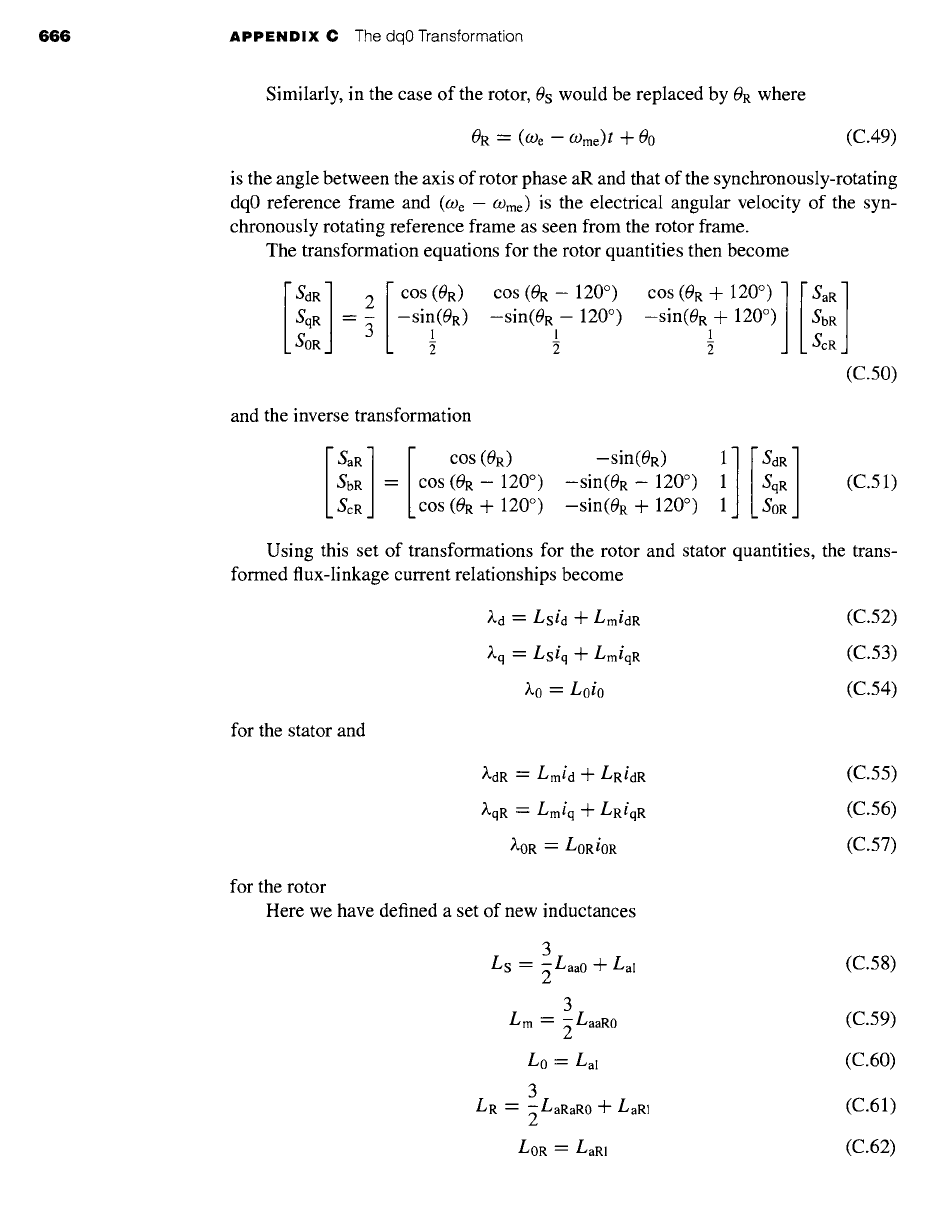
GGG
APPENDIX C The dqO Transformation
Similarly, in the case of the rotor, 0s would be replaced by OR where
OR -- (O)e -- O)me)t + 00
(C.49)
is the angle between the axis of rotor phase aR and that of the synchronously-rotating
dq0 reference frame and (We
- (-Ome)
is the electrical angular velocity of the syn-
chronously rotating reference frame as seen from the rotor frame.
The transformation equations for the rotor quantities then become
[*dR] 2 E COS 0R
-- --sin(0R)
s~ ~ 1
S0R
cos 0R 120o cos +,20o 1E,aR ]
--sin(0R- 120 °) --sin(0R + 120 °)
SbR
1 1 Sc R
(c.50)
and the inverse transformation
EsaRI E cos 0R sin 0R
SbR --
COS (OR-
120 °) --sin(0R- 120 °) 1
SqR
ScR COS (O R -~-
120 °) --sin(0R + 120 °) 1
S0R
(C.51)
Using this set of transformations for the rotor and stator quantities, the trans-
formed flux-linkage current relationships become
~.d "--
Lsid + LmidR (C.52)
~.q =
Lsiq + LmiqR (C.53)
)~o = Loio (C.54)
for the stator and
~.dR -- Lmid q- LRidR (C.55)
~qR = Lmiq + LRiqR (C.56)
~.0R = LORi0R (C.57)
for the rotor
Here we have defined a set of new inductances
3
Ls -- ~Laa0
q- Lal
3
Lm -- ~LaaR0
Lo : Lal
3
LR -- ~LaRaR0 + LaRI
L0R : LaRI
(c.58)
(c.59)
(c.60)
(c.61)
(c.62)
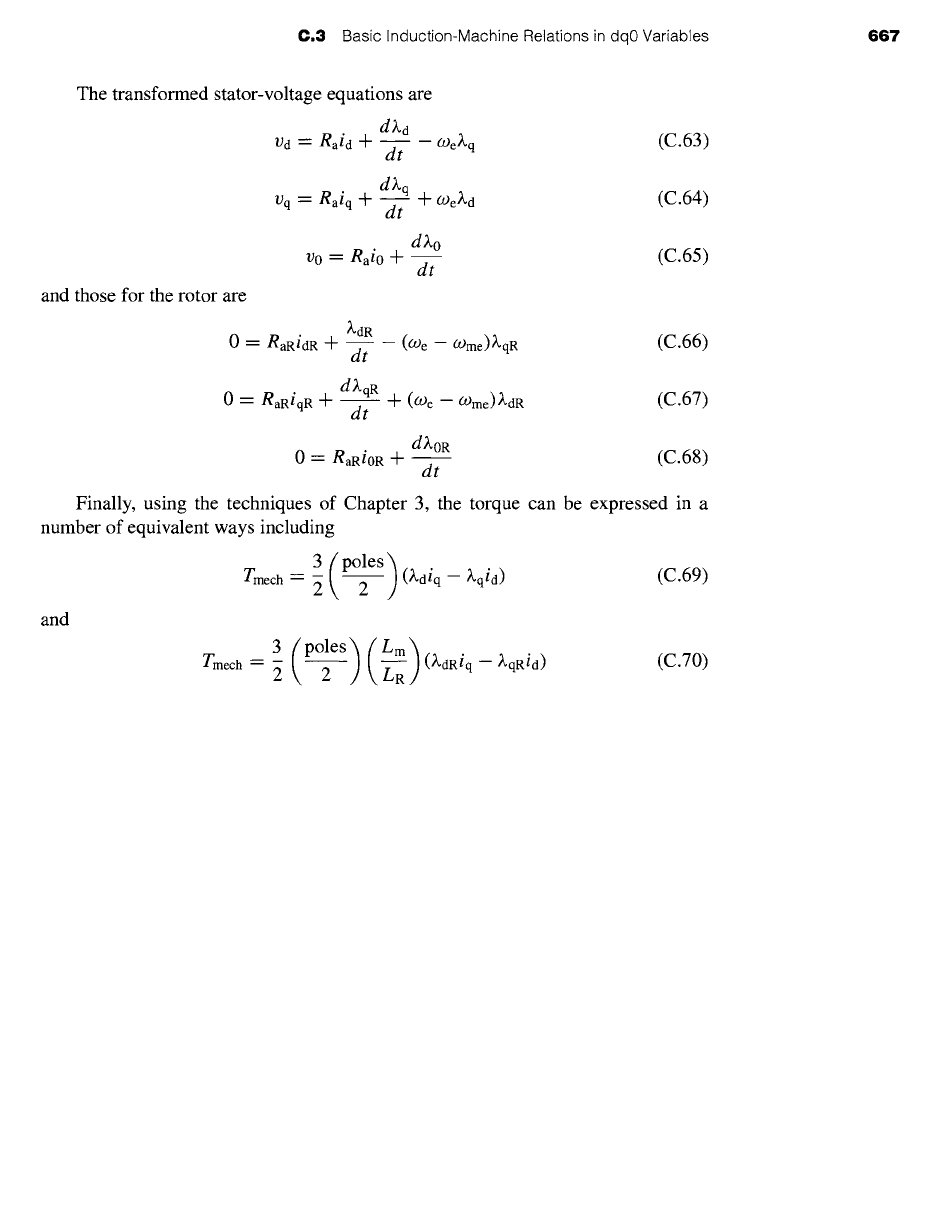
C,3
Basic Induction-Machine Relations in dqO Variables
667
The transformed stator-voltage equations are
d)~d
Vd -- Raid n t- --dtt- -
O')e~'q
(C.63)
d)~q
Vq = Raiq Jr- ~ +
WeLd (C.64)
d)~0
vo = Raio +
(C.65)
dt
and those for the rotor are
~,dR
0 = RaRidR + --~ -- (We
-(-Ome)~,qR
(C.66)
dLqR
0 = RaRiqR n t-
dt
+
(tOe --(-Ome)).dR
(C.67)
d)~0R
0-- RaRi0R -~- ~ (C.68)
dt
Finally, using the techniques of Chapter 3, the torque can be expressed in a
number of equivalent ways including
and
Tmech -- ~ 2 (~,diq -- ~,qid)
3 (ples
/(
= ~R) (~,dRiq ~'qRid)
(C.69)
(c.7o)
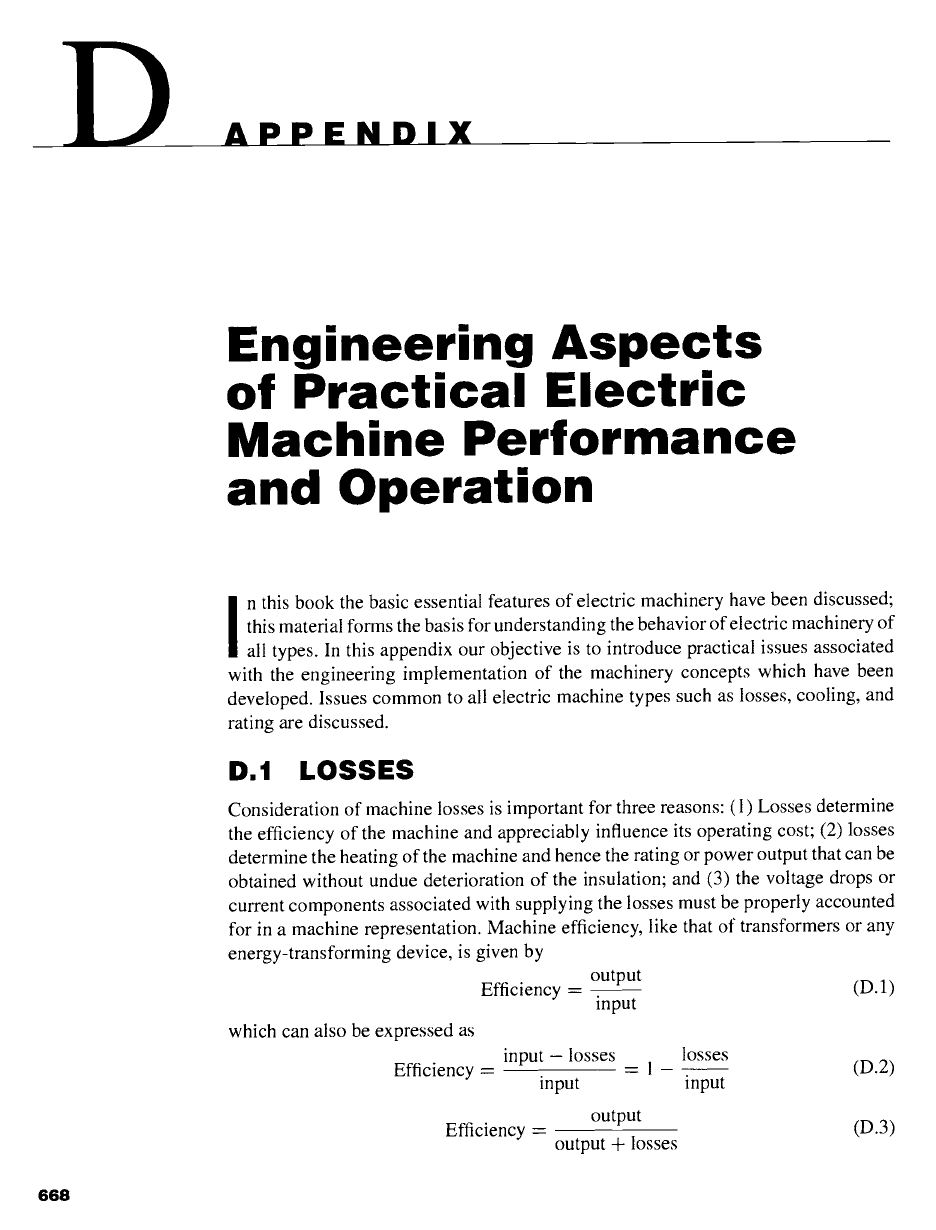
APPFNnlX
Engineering Aspects
of Practical Electric
Machine Performance
and Operation
I
n this book the basic essential features of electric machinery have been discussed;
this material forms the basis for understanding the behavior of electric machinery of
all types. In this appendix our objective is to introduce practical issues associated
with the engineering implementation of the machinery concepts which have been
developed. Issues common to all electric machine types such as losses, cooling, and
rating are discussed.
D.1 LOSSES
Consideration of machine losses is important for three reasons: (1) Losses determine
the efficiency of the machine and appreciably influence its operating cost; (2) losses
determine the heating of the machine and hence the rating or power output that can be
obtained without undue deterioration of the insulation; and (3) the voltage drops or
current components associated with supplying the losses must be properly accounted
for in a machine representation. Machine efficiency, like that of transformers or any
energy-transforming device, is given by
Efficiency - output (D. 1)
input
which can also be expressed as
input- losses losses
Efficiency = = 1 (D.2)
input input
Efficiency -- output (D.3)
output + losses
668
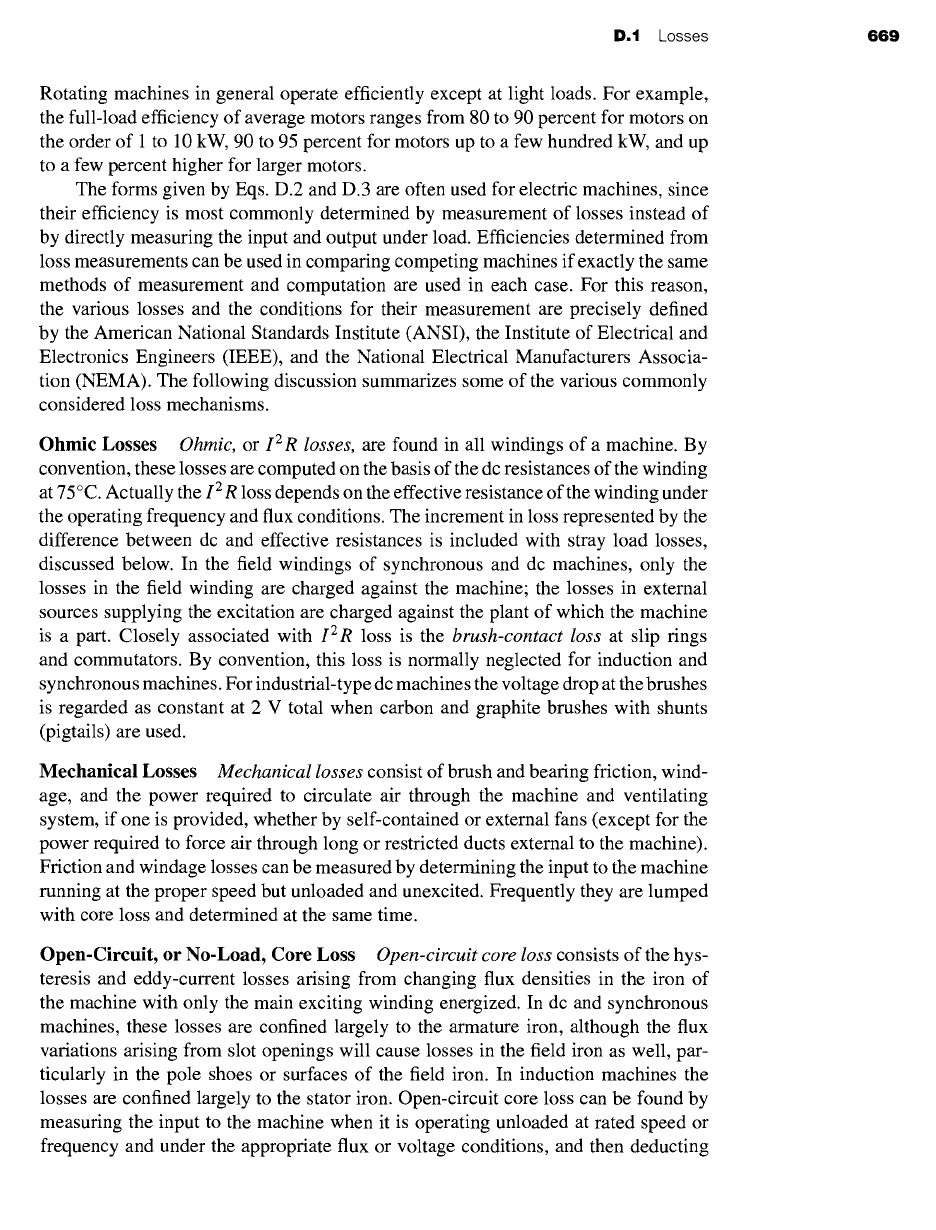
D.1 Losses 669
Rotating machines in general operate efficiently except at light loads. For example,
the full-load efficiency of average motors ranges from 80 to 90 percent for motors on
the order of 1 to 10 kW, 90 to 95 percent for motors up to a few hundred kW, and up
to a few percent higher for larger motors.
The forms given by Eqs. D.2 and D.3 are often used for electric machines, since
their efficiency is most commonly determined by measurement of losses instead of
by directly measuring the input and output under load. Efficiencies determined from
loss measurements can be used in comparing competing machines if exactly the same
methods of measurement and computation are used in each case. For this reason,
the various losses and the conditions for their measurement are precisely defined
by the American National Standards Institute (ANSI), the Institute of Electrical and
Electronics Engineers (IEEE), and the National Electrical Manufacturers Associa-
tion (NEMA). The following discussion summarizes some of the various commonly
considered loss mechanisms.
Ohmic Losses Ohmic, or I2R losses, are found in all windings of a machine. By
convention, these losses are computed on the basis of the dc resistances of the winding
at 75°C. Actually the 12 R loss depends on the effective resistance of the winding under
the operating frequency and flux conditions. The increment in loss represented by the
difference between dc and effective resistances is included with stray load losses,
discussed below. In the field windings of synchronous and dc machines, only the
losses in the field winding are charged against the machine; the losses in external
sources supplying the excitation are charged against the plant of which the machine
is a part. Closely associated with I2R loss is the brush-contact loss at slip rings
and commutators. By convention, this loss is normally neglected for induction and
synchronous machines. For industrial-type dc machines the voltage drop at the brushes
is regarded as constant at 2 V total when carbon and graphite brushes with shunts
(pigtails) are used.
Mechanical Losses Mechanical losses consist of brush and bearing friction, wind-
age, and the power required to circulate air through the machine and ventilating
system, if one is provided, whether by self-contained or external fans (except for the
power required to force air through long or restricted ducts external to the machine).
Friction and windage losses can be measured by determining the input to the machine
running at the proper speed but unloaded and unexcited. Frequently they are lumped
with core loss and determined at the same time.
Open-Circuit, or No-Load, Core Loss Open-circuit core loss consists of the hys-
teresis and eddy-current losses arising from changing flux densities in the iron of
the machine with only the main exciting winding energized. In dc and synchronous
machines, these losses are confined largely to the armature iron, although the flux
variations arising from slot openings will cause losses in the field iron as well, par-
ticularly in the pole shoes or surfaces of the field iron. In induction machines the
losses are confined largely to the stator iron. Open-circuit core loss can be found by
measuring the input to the machine when it is operating unloaded at rated speed or
frequency and under the appropriate flux or voltage conditions, and then deducting
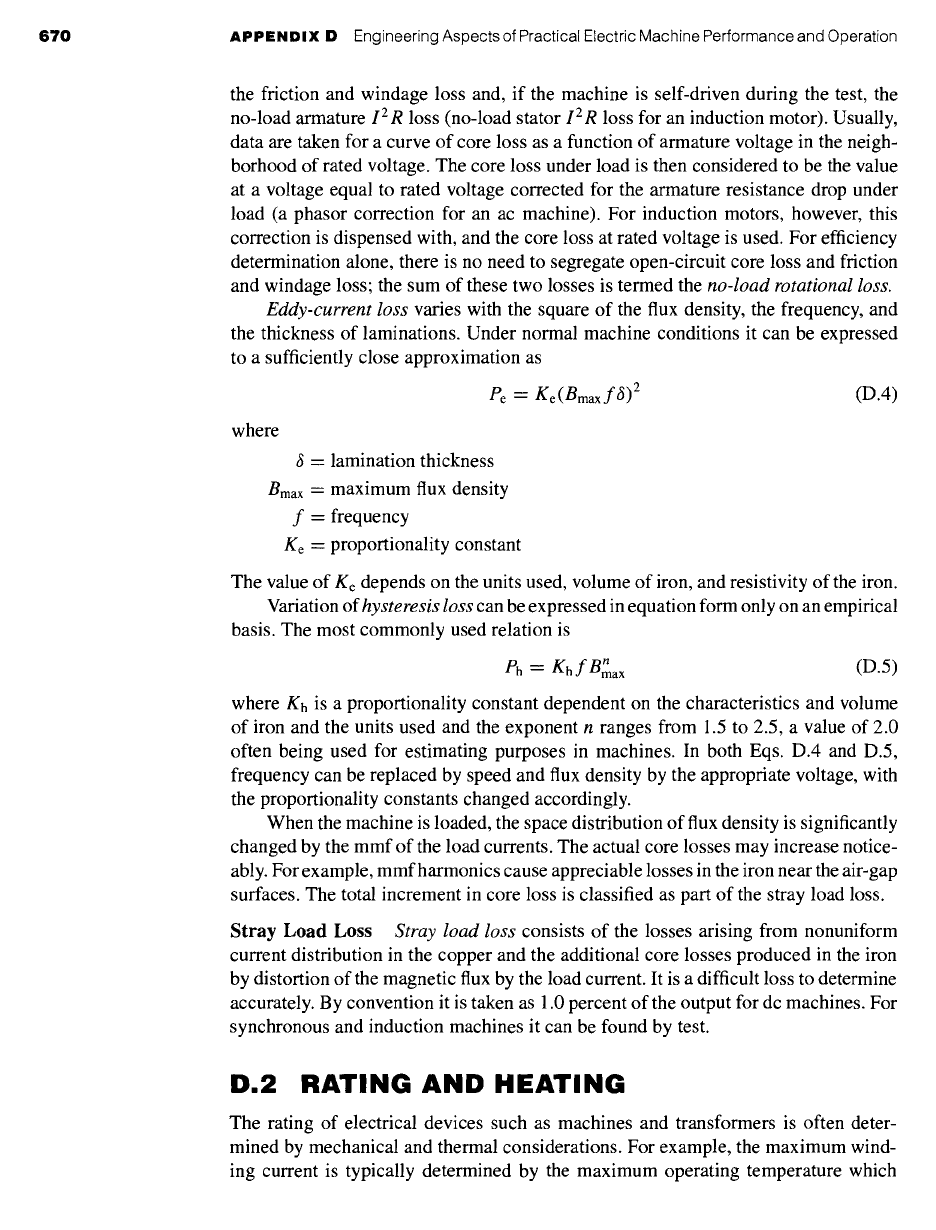
670 APPENDIX D Engineering Aspects of Practical Electric Machine Performance and Operation
the friction and windage loss and, if the machine is self-driven during the test, the
no-load armature I2R loss (no-load stator 12R loss for an induction motor). Usually,
data are taken for a curve of core loss as a function of armature voltage in the neigh-
borhood of rated voltage. The core loss under load is then considered to be the value
at a voltage equal to rated voltage corrected for the armature resistance drop under
load (a phasor correction for an ac machine). For induction motors, however, this
correction is dispensed with, and the core loss at rated voltage is used. For efficiency
determination alone, there is no need to segregate open-circuit core loss and friction
and windage loss; the sum of these two losses is termed the no-load rotational loss.
Eddy-current loss varies with the square of the flux density, the frequency, and
the thickness of laminations. Under normal machine conditions it can be expressed
to a sufficiently close approximation as
ee
--
Ke(Bmaxf t~) 2
(D.4)
where
- lamination thickness
Bmax --
maximum flux density
f = frequency
Ke =
proportionality constant
The value of Ke depends on the units used, volume of iron, and resistivity of the iron.
Variation of hysteresis loss can be expressed in equation form only on an empirical
basis. The most commonly used relation is
eh - ghf Bn
(D.5)
max
where Kh is a proportionality constant dependent on the characteristics and volume
of iron and the units used and the exponent n ranges from 1.5 to 2.5, a value of 2.0
often being used for estimating purposes in machines. In both Eqs. D.4 and D.5,
frequency can be replaced by speed and flux density by the appropriate voltage, with
the proportionality constants changed accordingly.
When the machine is loaded, the space distribution of flux density is significantly
changed by the mmf of the load currents. The actual core losses may increase notice-
ably. For example, mmf harmonics cause appreciable losses in the iron near the air-gap
surfaces. The total increment in core loss is classified as part of the stray load loss.
Stray Load Loss Stray load loss consists of the losses arising from nonuniform
current distribution in the copper and the additional core losses produced in the iron
by distortion of the magnetic flux by the load current. It is a difficult loss to determine
accurately. By convention it is taken as 1.0 percent of the output for dc machines. For
synchronous and induction machines it can be found by test.
D.2 RATING AND HEATING
The rating of electrical devices such as machines and transformers is often deter-
mined by mechanical and thermal considerations. For example, the maximum wind-
ing current is typically determined by the maximum operating temperature which
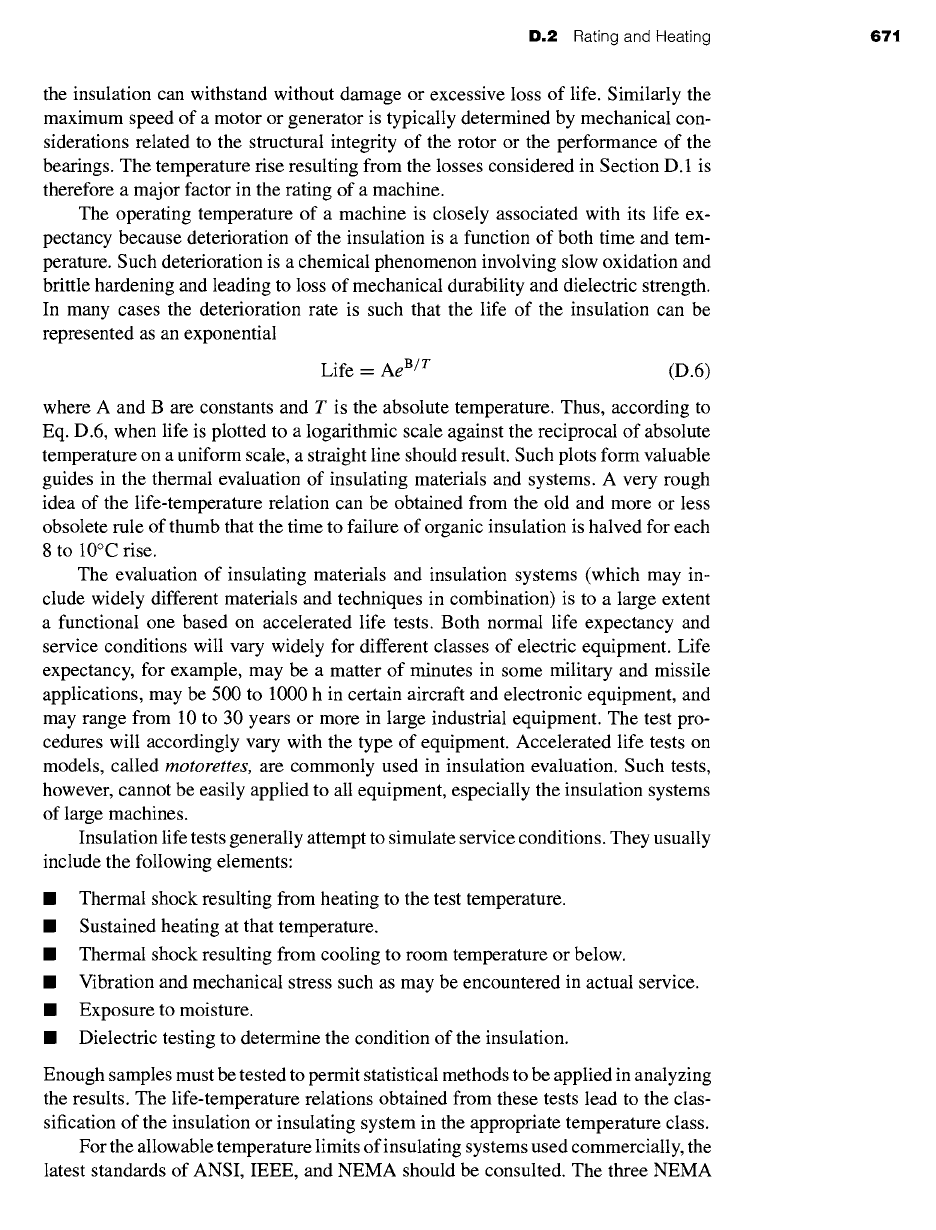
ID,2 Rating and Heating 671
the insulation can withstand without damage or excessive loss of life. Similarly the
maximum speed of a motor or generator is typically determined by mechanical con-
siderations related to the structural integrity of the rotor or the performance of the
bearings. The temperature rise resulting from the losses considered in Section D. 1 is
therefore a major factor in the rating of a machine.
The operating temperature of a machine is closely associated with its life ex-
pectancy because deterioration of the insulation is a function of both time and tem-
perature. Such deterioration is a chemical phenomenon involving slow oxidation and
brittle hardening and leading to loss of mechanical durability and dielectric strength.
In many cases the deterioration rate is such that the life of the insulation can be
represented as an exponential
Life = Ae B/T (D.6)
where A and B are constants and T is the absolute temperature. Thus, according to
Eq. D.6, when life is plotted to a logarithmic scale against the reciprocal of absolute
temperature on a uniform scale, a straight line should result. Such plots form valuable
guides in the thermal evaluation of insulating materials and systems. A very rough
idea of the life-temperature relation can be obtained from the old and more or less
obsolete rule of thumb that the time to failure of organic insulation is halved for each
8 to 10°C rise.
The evaluation of insulating materials and insulation systems (which may in-
clude widely different materials and techniques in combination) is to a large extent
a functional one based on accelerated life tests. Both normal life expectancy and
service conditions will vary widely for different classes of electric equipment. Life
expectancy, for example, may be a matter of minutes in some military and missile
applications, may be 500 to 1000 h in certain aircraft and electronic equipment, and
may range from 10 to 30 years or more in large industrial equipment. The test pro-
cedures will accordingly vary with the type of equipment. Accelerated life tests on
models, called motorettes, are commonly used in insulation evaluation. Such tests,
however, cannot be easily applied to all equipment, especially the insulation systems
of large machines.
Insulation life tests generally attempt to simulate service conditions. They usually
include the following elements:
m Thermal shock resulting from heating to the test temperature.
m Sustained heating at that temperature.
m Thermal shock resulting from cooling to room temperature or below.
m Vibration and mechanical stress such as may be encountered in actual service.
m Exposure to moisture.
l Dielectric testing to determine the condition of the insulation.
Enough samples must be tested to permit statistical methods to be applied in analyzing
the results. The life-temperature relations obtained from these tests lead to the clas-
sification of the insulation or insulating system in the appropriate temperature class.
For the allowable temperature limits of insulating systems used commercially, the
latest standards of ANSI, IEEE, and NEMA should be consulted. The three NEMA
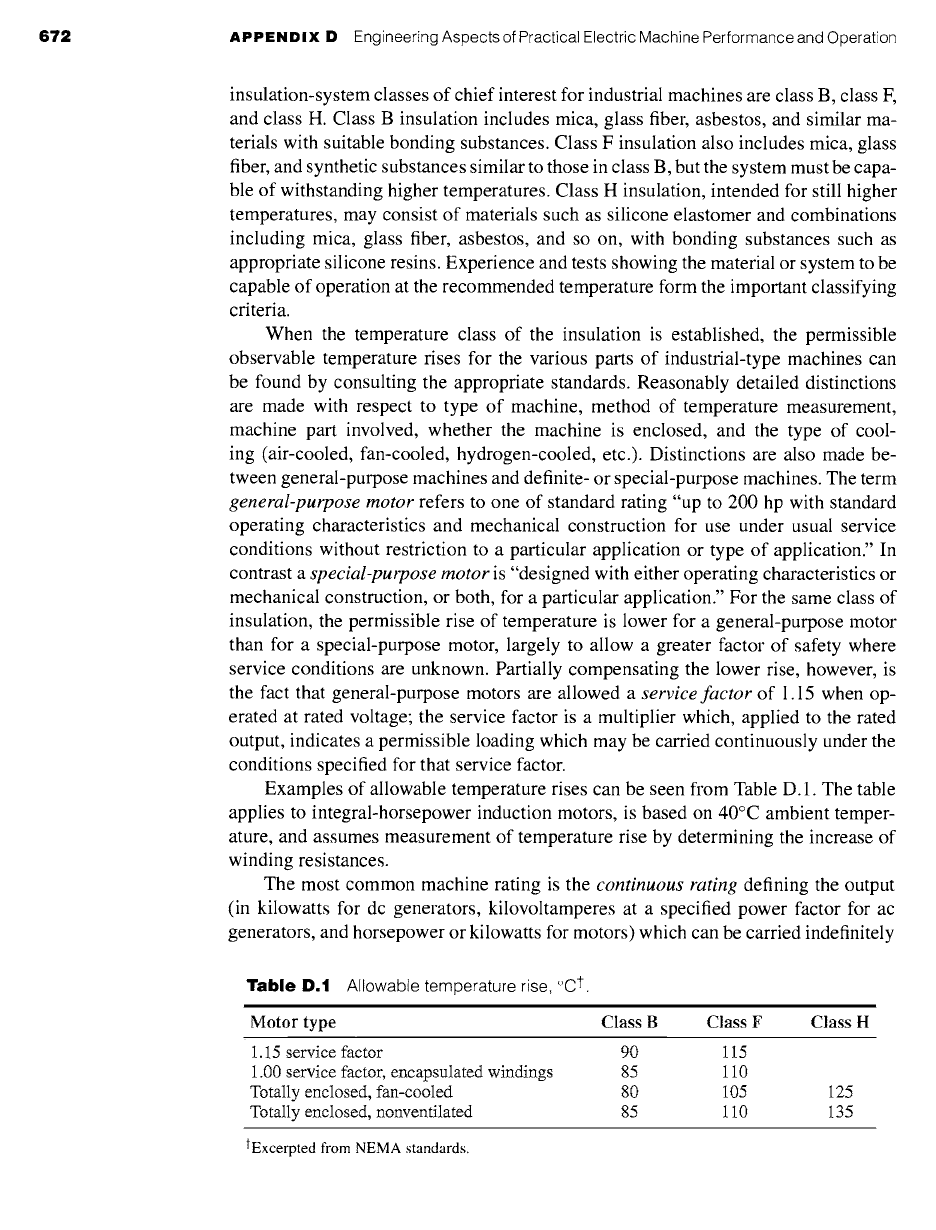
672
APPENDIX
D Engineering Aspects of Practical Electric Machine Performance and Operation
insulation-system classes of chief interest for industrial machines are class B, class F,
and class H. Class B insulation includes mica, glass fiber, asbestos, and similar ma-
terials with suitable bonding substances. Class F insulation also includes mica, glass
fiber, and synthetic substances similar to those in class B, but the system must be capa-
ble of withstanding higher temperatures. Class H insulation, intended for still higher
temperatures, may consist of materials such as silicone elastomer and combinations
including mica, glass fiber, asbestos, and so on, with bonding substances such as
appropriate silicone resins. Experience and tests showing the material or system to be
capable of operation at the recommended temperature form the important classifying
criteria.
When the temperature class of the insulation is established, the permissible
observable temperature rises for the various parts of industrial-type machines can
be found by consulting the appropriate standards. Reasonably detailed distinctions
are made with respect to type of machine, method of temperature measurement,
machine part involved, whether the machine is enclosed, and the type of cool-
ing (air-cooled, fan-cooled, hydrogen-cooled, etc.). Distinctions are also made be-
tween general-purpose machines and definite- or special-purpose machines. The term
general-purpose motor
refers to one of standard rating "up to 200 hp with standard
operating characteristics and mechanical construction for use under usual service
conditions without restriction to a particular application or type of application." In
contrast a
special-purpose motor
is "designed with either operating characteristics or
mechanical construction, or both, for a particular application." For the same class of
insulation, the permissible rise of temperature is lower for a general-purpose motor
than for a special-purpose motor, largely to allow a greater factor of safety where
service conditions are unknown. Partially compensating the lower rise, however, is
the fact that general-purpose motors are allowed a
service factor
of 1.15 when op-
erated at rated voltage; the service factor is a multiplier which, applied to the rated
output, indicates a permissible loading which may be carried continuously under the
conditions specified for that service factor.
Examples of allowable temperature rises can be seen from Table D. 1. The table
applies to integral-horsepower induction motors, is based on 40°C ambient temper-
ature, and assumes measurement of temperature rise by determining the increase of
winding resistances.
The most common machine rating is the
continuous rating
defining the output
(in kilowatts for dc generators, kilovoltamperes at a specified power factor for ac
generators, and horsepower or kilowatts for motors) which can be carried indefinitely
Table
D.1 Allowable temperature rise, °Ct.
Motor type Class B Class F Class H
1.15 service factor
1.00 service factor, encapsulated windings
Totally enclosed, fan-cooled
Totally enclosed, nonventilated
90 115
85 110
80 105
85 110
125
135
t Excerpted from NEMA standards.
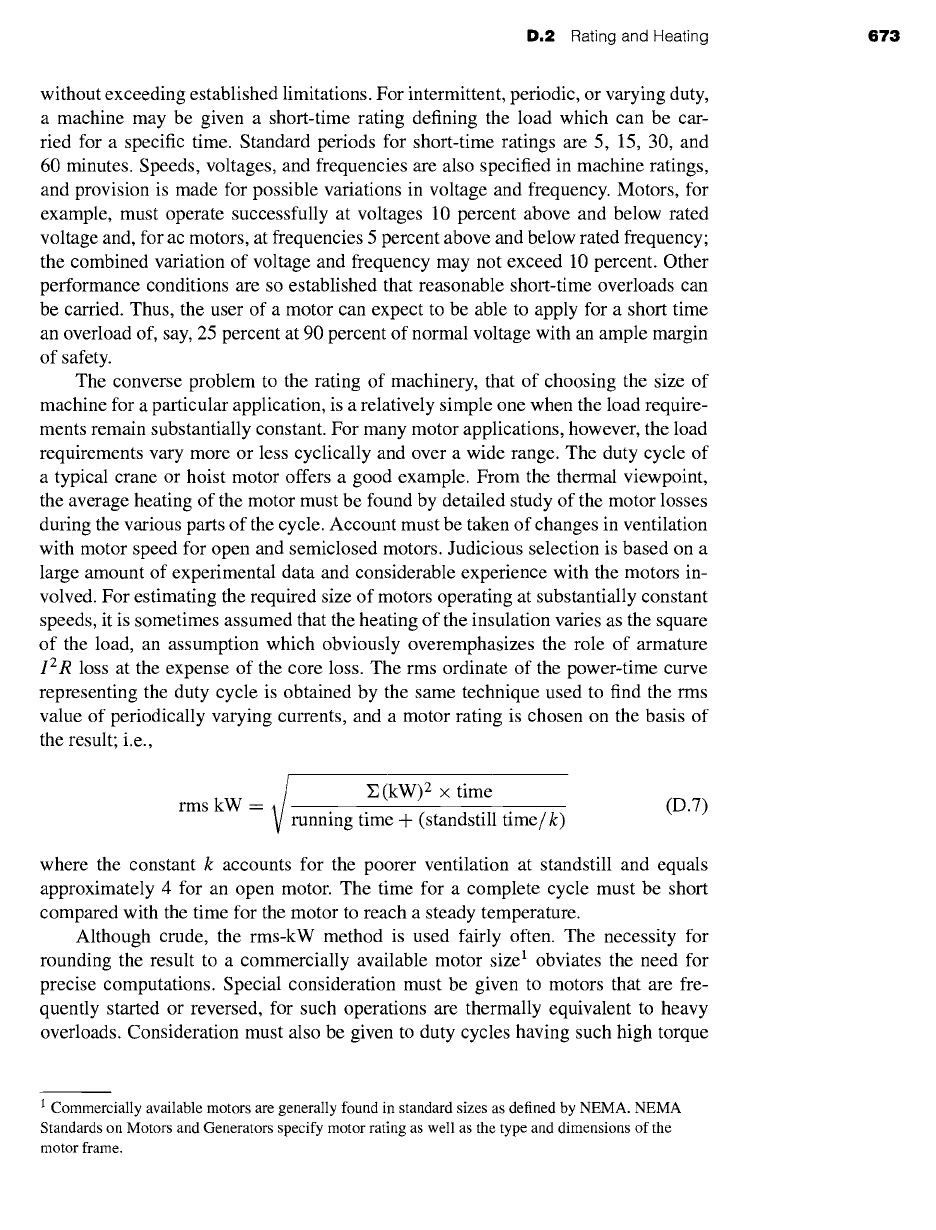
#,2 Rating and Heating 678
without exceeding established limitations. For intermittent, periodic, or varying duty,
a machine may be given a short-time rating defining the load which can be car-
ried for a specific time. Standard periods for short-time ratings are 5, 15, 30, and
60 minutes. Speeds, voltages, and frequencies are also specified in machine ratings,
and provision is made for possible variations in voltage and frequency. Motors, for
example, must operate successfully at voltages 10 percent above and below rated
voltage and, for ac motors, at frequencies 5 percent above and below rated frequency;
the combined variation of voltage and frequency may not exceed 10 percent. Other
performance conditions are so established that reasonable short-time overloads can
be carried. Thus, the user of a motor can expect to be able to apply for a short time
an overload of, say, 25 percent at 90 percent of normal voltage with an ample margin
of safety.
The converse problem to the rating of machinery, that of choosing the size of
machine for a particular application, is a relatively simple one when the load require-
ments remain substantially constant. For many motor applications, however, the load
requirements vary more or less cyclically and over a wide range. The duty cycle of
a typical crane or hoist motor offers a good example. From the thermal viewpoint,
the average heating of the motor must be found by detailed study of the motor losses
during the various parts of the cycle. Account must be taken of changes in ventilation
with motor speed for open and semiclosed motors. Judicious selection is based on a
large amount of experimental data and considerable experience with the motors in-
volved. For estimating the required size of motors operating at substantially constant
speeds, it is sometimes assumed that the heating of the insulation varies as the square
of the load, an assumption which obviously overemphasizes the role of armature
IZR loss at the expense of the core loss. The rms ordinate of the power-time curve
representing the duty cycle is obtained by the same technique used to find the rms
value of periodically varying currents, and a motor rating is chosen on the basis of
the result; i.e.,
~](kW) 2 x time
rms kW - running time 4- (standstill time/k)
(D.7)
where the constant k accounts for the poorer ventilation at standstill and equals
approximately 4 for an open motor. The time for a complete cycle must be short
compared with the time for the motor to reach a steady temperature.
Although crude, the rms-kW method is used fairly often. The necessity for
rounding the result to a commercially available motor size 1 obviates the need for
precise computations. Special consideration must be given to motors that are fre-
quently started or reversed, for such operations are thermally equivalent to heavy
overloads. Consideration must also be given to duty cycles having such high torque
1 Commercially available motors are generally found in standard sizes as defined by NEMA. NEMA
Standards on Motors and Generators specify motor rating as well as the type and dimensions of the
motor frame.
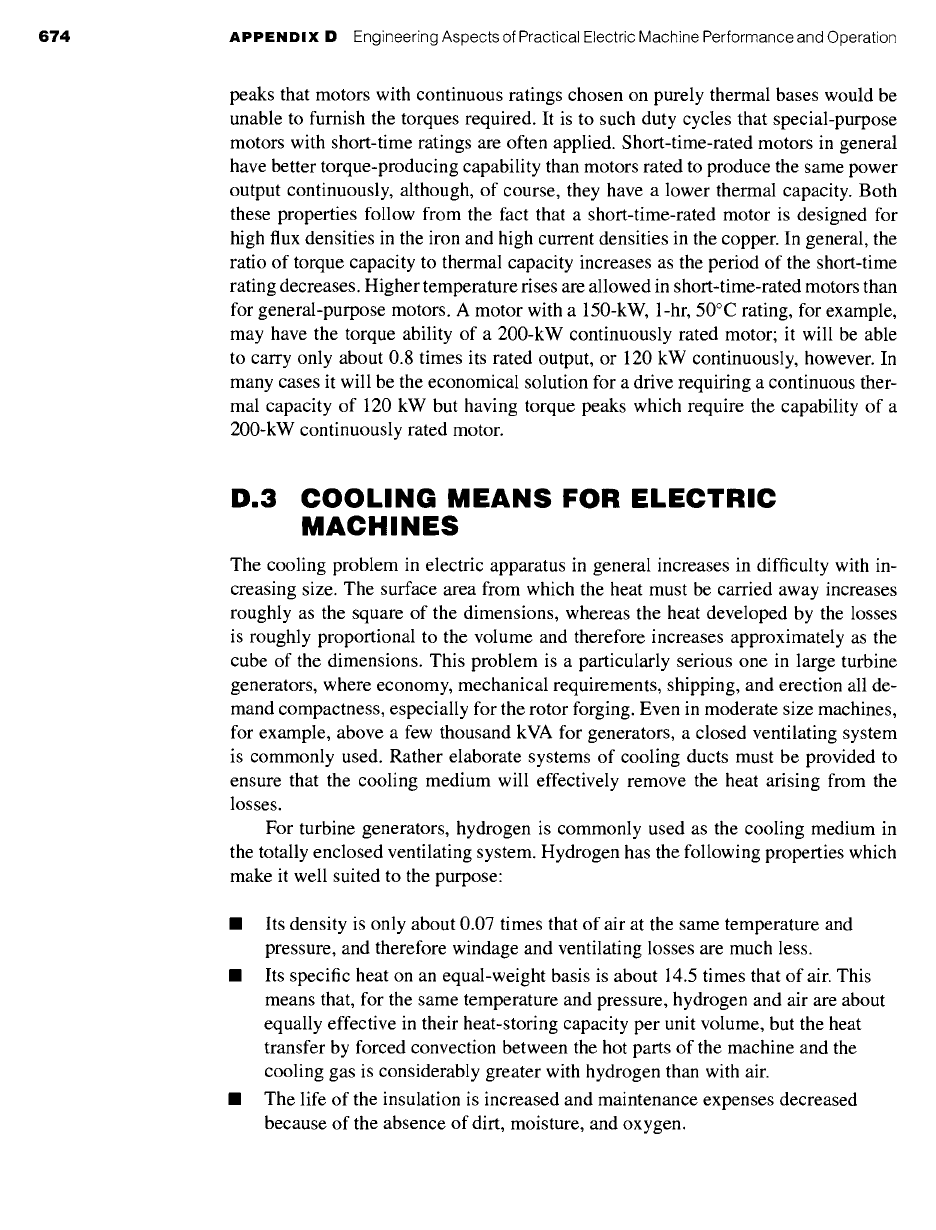
674
APPENDIX
D Engineering Aspects of Practical Electric Machine Performance and Operation
peaks that motors with continuous ratings chosen on purely thermal bases would be
unable to furnish the torques required. It is to such duty cycles that special-purpose
motors with short-time ratings are often applied. Short-time-rated motors in general
have better torque-producing capability than motors rated to produce the same power
output continuously, although, of course, they have a lower thermal capacity. Both
these properties follow from the fact that a short-time-rated motor is designed for
high flux densities in the iron and high current densities in the copper. In general, the
ratio of torque capacity to thermal capacity increases as the period of the short-time
rating decreases. Higher temperature rises are allowed in short-time-rated motors than
for general-purpose motors. A motor with a 150-kW, 1-hr, 50°C rating, for example,
may have the torque ability of a 200-kW continuously rated motor; it will be able
to carry only about 0.8 times its rated output, or 120 kW continuously, however. In
many cases it will be the economical solution for a drive requiring a continuous ther-
mal capacity of 120 kW but having torque peaks which require the capability of a
200-kW continuously rated motor.
D.3 COOLING MEANS FOR ELECTRIC
MACHINES
The cooling problem in electric apparatus in general increases in difficulty with in-
creasing size. The surface area from which the heat must be carried away increases
roughly as the square of the dimensions, whereas the heat developed by the losses
is roughly proportional to the volume and therefore increases approximately as the
cube of the dimensions. This problem is a particularly serious one in large turbine
generators, where economy, mechanical requirements, shipping, and erection all de-
mand compactness, especially for the rotor forging. Even in moderate size machines,
for example, above a few thousand kVA for generators, a closed ventilating system
is commonly used. Rather elaborate systems of cooling ducts must be provided to
ensure that the cooling medium will effectively remove the heat arising from the
losses.
For turbine generators, hydrogen is commonly used as the cooling medium in
the totally enclosed ventilating system. Hydrogen has the following properties which
make it well suited to the purpose:
m Its density is only about 0.07 times that of air at the same temperature and
pressure, and therefore windage and ventilating losses are much less.
m Its specific heat on an equal-weight basis is about 14.5 times that of air. This
means that, for the same temperature and pressure, hydrogen and air are about
equally effective in their heat-storing capacity per unit volume, but the heat
transfer by forced convection between the hot parts of the machine and the
cooling gas is considerably greater with hydrogen than with air.
m The life of the insulation is increased and maintenance expenses decreased
because of the absence of dirt, moisture, and oxygen.
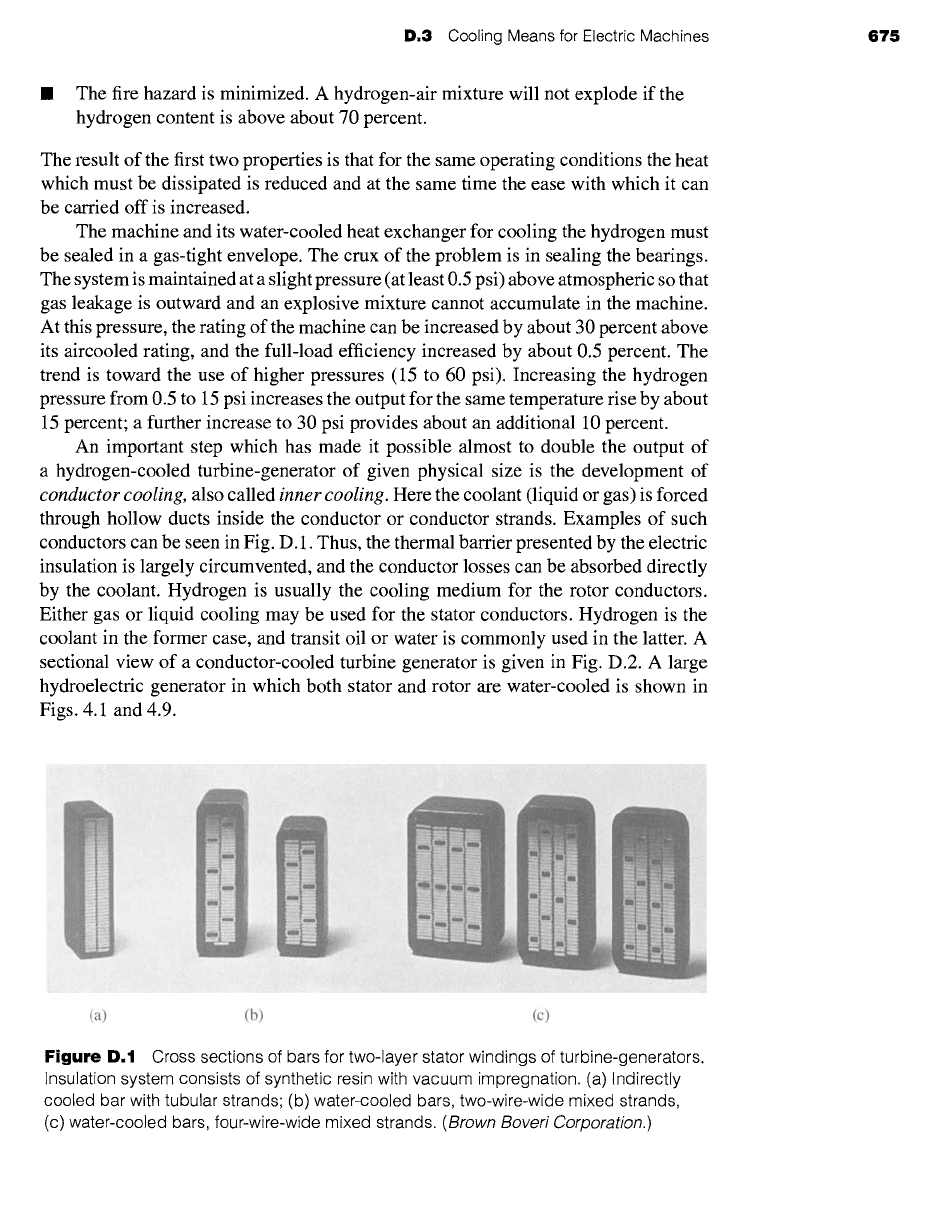
D.3 Cooling Means for Electric Machines 675
The fire hazard is minimized. A hydrogen-air mixture will not explode if the
hydrogen content is above about 70 percent.
The result of the first two properties is that for the same operating conditions the heat
which must be dissipated is reduced and at the same time the ease with which it can
be carried off is increased.
The machine and its water-cooled heat exchanger for cooling the hydrogen must
be sealed in a gas-tight envelope. The crux of the problem is in sealing the bearings.
The system is maintained at a slight pressure (at least 0.5 psi) above atmospheric so that
gas leakage is outward and an explosive mixture cannot accumulate in the machine.
At this pressure, the rating of the machine can be increased by about 30 percent above
its aircooled rating, and the full-load efficiency increased by about 0.5 percent. The
trend is toward the use of higher pressures (15 to 60 psi). Increasing the hydrogen
pressure from 0.5 to 15 psi increases the output for the same temperature rise by about
15 percent; a further increase to 30 psi provides about an additional 10 percent.
An important step which has made it possible almost to double the output of
a hydrogen-cooled turbine-generator of given physical size is the development of
conductor cooling,
also called
inner cooling.
Here the coolant (liquid or gas) is forced
through hollow ducts inside the conductor or conductor strands. Examples of such
conductors can be seen in Fig. D. 1. Thus, the thermal barrier presented by the electric
insulation is largely circumvented, and the conductor losses can be absorbed directly
by the coolant. Hydrogen is usually the cooling medium for the rotor conductors.
Either gas or liquid cooling may be used for the stator conductors. Hydrogen is the
coolant in the former case, and transit oil or water is commonly used in the latter. A
sectional view of a conductor-cooled turbine generator is given in Fig. D.2. A large
hydroelectric generator in which both stator and rotor are water-cooled is shown in
Figs. 4.1 and 4.9.
(a) (b) (c)
Figure
D.1 Cross sections of bars for two-layer stator windings of turbine-generators.
Insulation system consists of synthetic resin with vacuum impregnation. (a) Indirectly
cooled bar with tubular strands; (b) water-cooled bars, two-wire-wide mixed strands,
(c) water-cooled bars, four-wire-wide mixed strands.
(Brown Boveri Corporation.)
